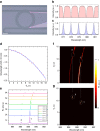On-chip single photon filtering and multiplexing in hybrid quantum photonic circuits
- PMID: 28855499
- PMCID: PMC5577278
- DOI: 10.1038/s41467-017-00486-8
On-chip single photon filtering and multiplexing in hybrid quantum photonic circuits
Abstract
Quantum light plays a pivotal role in modern science and future photonic applications. Since the advent of integrated quantum nanophotonics different material platforms based on III-V nanostructures-, colour centers-, and nonlinear waveguides as on-chip light sources have been investigated. Each platform has unique advantages and limitations; however, all implementations face major challenges with filtering of individual quantum states, scalable integration, deterministic multiplexing of selected quantum emitters, and on-chip excitation suppression. Here we overcome all of these challenges with a hybrid and scalable approach, where single III-V quantum emitters are positioned and deterministically integrated in a complementary metal-oxide-semiconductor-compatible photonic circuit. We demonstrate reconfigurable on-chip single-photon filtering and wavelength division multiplexing with a foot print one million times smaller than similar table-top approaches, while offering excitation suppression of more than 95 dB and efficient routing of single photons over a bandwidth of 40 nm. Our work marks an important step to harvest quantum optical technologies' full potential.Combining different integration platforms on the same chip is currently one of the main challenges for quantum technologies. Here, Elshaari et al. show III-V Quantum Dots embedded in nanowires operating in a CMOS compatible circuit, with controlled on-chip filtering and tunable routing.
Conflict of interest statement
The authors declare no competing financial interests.
Figures





References
-
- Pieter K, et al. Linear optical quantum computing with photonic qubits. Rev. Mod. Phys. 2007;79:135–174. doi: 10.1103/RevModPhys.79.135. - DOI
-
- Clevenson H, et al. Broadband magnetometry and temperature sensing with a light-trapping diamond waveguide. Nat. Phys. 2015;11:393–397. doi: 10.1038/nphys3291. - DOI
-
- Khasminskaya S, et al. Fully integrated quantum photonic circuit with an electrically driven light source. Nat. Photon. 2016;10:727–732. doi: 10.1038/nphoton.2016.178. - DOI
Publication types
Grants and funding
LinkOut - more resources
Full Text Sources
Other Literature Sources
Miscellaneous

